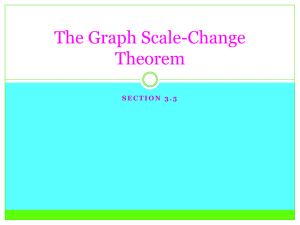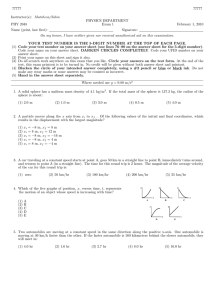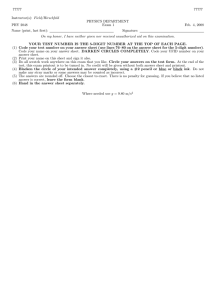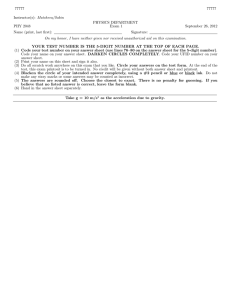Physics 221 - Spring 2001 - Exam 1 Name and ID Section
advertisement
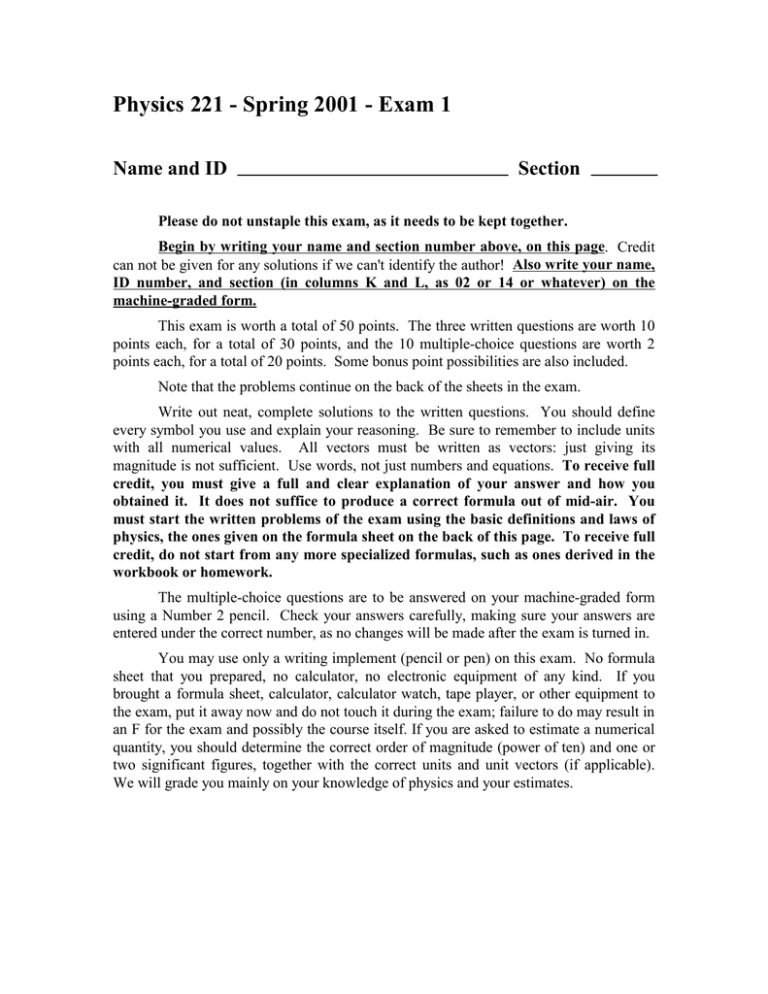
Physics 221 - Spring 2001 - Exam 1
Name and ID
Section
Please do not unstaple this exam, as it needs to be kept together.
Begin by writing your name and section number above, on this page. Credit
can not be given for any solutions if we can't identify the author! Also write your name,
ID number, and section (in columns K and L, as 02 or 14 or whatever) on the
machine-graded form.
This exam is worth a total of 50 points. The three written questions are worth 10
points each, for a total of 30 points, and the 10 multiple-choice questions are worth 2
points each, for a total of 20 points. Some bonus point possibilities are also included.
Note that the problems continue on the back of the sheets in the exam.
Write out neat, complete solutions to the written questions. You should define
every symbol you use and explain your reasoning. Be sure to remember to include units
with all numerical values. All vectors must be written as vectors: just giving its
magnitude is not sufficient. Use words, not just numbers and equations. To receive full
credit, you must give a full and clear explanation of your answer and how you
obtained it. It does not suffice to produce a correct formula out of mid-air. You
must start the written problems of the exam using the basic definitions and laws of
physics, the ones given on the formula sheet on the back of this page. To receive full
credit, do not start from any more specialized formulas, such as ones derived in the
workbook or homework.
The multiple-choice questions are to be answered on your machine-graded form
using a Number 2 pencil. Check your answers carefully, making sure your answers are
entered under the correct number, as no changes will be made after the exam is turned in.
You may use only a writing implement (pencil or pen) on this exam. No formula
sheet that you prepared, no calculator, no electronic equipment of any kind. If you
brought a formula sheet, calculator, calculator watch, tape player, or other equipment to
the exam, put it away now and do not touch it during the exam; failure to do may result in
an F for the exam and possibly the course itself. If you are asked to estimate a numerical
quantity, you should determine the correct order of magnitude (power of ten) and one or
two significant figures, together with the correct units and unit vectors (if applicable).
We will grade you mainly on your knowledge of physics and your estimates.
Fundamental SI units
length: meter (m)
time: second (s)
mass: kilogram (kg)
current: ampere (A)
Derived SI units
newton (N) ~ kg h m/s
joule (J) ~ N h m
watt (W) ~ J/s
coulomb (C) ~ A h s
volt (V) ~ J/C
ohm (+) ~ V/A
farad (F) ~ C/V
SI prefixes
! and
!
and W W d -W
9~ (
, 2 b<
,W -W elec °
5 and ~ 5
"=
)E
Phenomenological relationships
= ~ 09
"<elec
W #W
-W net -W > -W h W
"<
c >c
2 #
(W ~ 8in °
Derived relationships
%
!
W(!) ~ W b #W ! b !
W
%(!) ~ % b ( cos ( ! b )
²!³ ~ 0 b
%(!) ~ % b ( sin ( ! b )
0!
b
!
> ~ >c b >nc
>net ~ "2 ;
", ~ >nc
2 ~ 2cm b 2rel
~ 0 ; 3 ~ 0 ; 7 ~ <grav ~ &
~
l°;
<elec ~ b 9
= ~ * ~ (°
~
b % ~ 0 solutions:
Special Relativity
l1c1(#/)
W #
W
, ~ ~ b 2
, ~ ( ) b ( )
%Z ~ (% c #!); & Z ~ & ; ' Z ~ ' ;
#%
!Z ~ 4! c 5
<sp ~ ²% c % ³
<grav ~ c . 7 > °!
b V
k ((% )& c )% (& )
sin 30° ~ 0.5 ~ cos 60°
cos 30° 0.9 sin 60°
sin 37° ~ 0.6 ~ cos 53°
cos 37° ~ 0.8 ~ sin 53°
cos 45° 0.7 sin 45°
~ #/; ~ ~ # °
3W
!
2rot ~ 0
b (2& b (2'
(W d )W ~
b Vi ((& )' c )& (' )
b Vj ((' )% c )' (% )
O O
O-W elec O ~ h
2
%
~ ( % )% b ( & ) & b ( ' ) '
Fundamental laws
W
-W net ~ W ~ !
,W
m(
(W h )W ~ () cos °
9*
O-W grav O ~ .
W
acceleration: W #
!
( ~ |(W| ~
* 8°=
" < °(volume)
1 0°(
1W ,W defines Physical constants
W
velocity: #W !
Mathematical and geometrical
relationships
~ c ,W h W
,W h (W
W net ~
Definitions
3
WM W d W
0 G ~ giga ~ 109
M ~ mega ~ 106
k ~ kilo ~ 10
c ~ centi ~ 10c
m ~ milli ~ 10c
~ micro ~ 10c6
n ~ nano ~ 10c9
. ~ 6.67 d 10c N h m /kg
~ 3À00 d 10 m/s
~ 6.63 d 10c4 J h s
K ~ 2 ~ 1.05 d 10c4 J h s
1
~ 4
0
~ 9 d 109 N h m /C
~ 1.6 d 10c9 C
~ 8.85 d 10c C /N h m
10 N/kg
~ 9.1 d 10c3 kg
~ 1.7 d 10c7 kg
1 eV ~ 1.6 d 10c9 J
< ~ 8=
l°3
P221/S2001/Problem 1A
Answer the questions below based on
this diagram. Remember to explain
how you obtained each result.
12
10
v x (m /s )
The diagram to the right shows the
velocity component #% ²!³ for an object
moving along the % axis.
8
6
4
2
0
1
2
3
4
5
6
7
8
9 10 11
t (s )
(a) [2 points] What was the displacement of the particle from ! ~ 1 s to ! ~ 3 s?
(Include the appropriate sign.)
(b) [2 points] What was the sign of the %-component of the velocity at the time
! ~ 7.5 s?
(c) [2 points] What was the sign of the %-component of the acceleration at the time
! ~ 7.5 s?
(d) [2 points] What was the %-component of the average acceleration from ! ~ 7.0 s
to ! ~ 8.0 s?
(e) [2 points] What is the change in % from ! ~ 7.0 s to ! ~ 8.0 s?
P221/S2001/Problem 1B
A stone is thrown from the top of a cliff of height 30.0 m, upward at an angle of 30°
to the horizontal, with an initial speed #0 ~ 20.0 m/s. Remember: begin using the
formulas on the formula sheet c don't just bring out a more specialized formula
that you happen to remember. Also remember that we only wanted the numerical
answers estimated. Take the positive & axis to be vertically upward and the positive
% direction to be in the horizontal direction of the stone's motion, and use the
approximation ~ 10 m/s2 .
(a) [2 points] How long is the stone in the air before it reaches its maximum height?
(b) [3 points] What is the maximum height that the stone reaches?
(c) [2 points] What is the velocity of the stone when it is at its maximum height?
(d) [3 points] How far in the horizontal direction has the stone moved during that
time?
(e) [2 bonus points] At what time will the stone strike the ground?
P221/S2001/Problem 1C
A person is pushing a box with a mass of
20 kg along a horizontal surface with a
force of 200 N down at an angle of 30°
below the horizontal, as shown in the
diagram. The coefficient of kinetic
friction between the box and the surface
is 0.50.
(a) [4 points] Draw a free-body diagram for the box, showing all the forces acting
on it and their correct directions.
(b) [4 points] Estimate the magnitude of each of the other forces on the box.
(c) [2 points] Estimate the acceleration of the box.
(d) [2 bonus points] How much work is done by the person pushing the box while
the box moves 3.0 m?
MULTIPLE-CHOICE QUESTIONS
Answer these questions (worth 2 points each) on the machine-gradeable form.
1. Which of the following is closest to your height?
(A) 0.02 m
(B) 0.2 m
(C) 2 m
(D) 20 m
(E) 200 m
2. 1 mile is equivalent to 1609 m. 55 miles per hour is approximately
(A) 15 m/s
(B) 25 m/s
(C) 66 m/s
(D) 88 m/s
(E) 1500 m/s
3. The number of significant figures in 0.00150 is
(A) 2
(B) 3
(C) 4
(D) 5
(E) 6
W ~ 2.0 Vi b 6.0Vj c 3.0 V
W is
4. Let (
k . The magnitude of (
(A) 5.0
(B) 6.0
(C) 7.0
(D) 8.0
(E) 9.0
5. A boy pulls a wooden box of mass along a rough horizontal floor at constant
W . The force diagram for the box is shown below. Which
speed by means of a force 7
of the following must be true, where and 5 are, respectively, the magnitudes of
the frictional and normal forces?
(A) 7 and 5 ~ (B) 7 ~ and 5 ~ (C) 7 and 5 (D) 7 ~ and 5 (E) None of the above
5W
§
W RTT TTS 7W
¨
W
6. An object moves in a circle at constant speed. The work done by the centripetal
force is zero because:
(A) there is no friction.
(B) the acceleration has zero magnitude.
(C) the average force (per revolution) is zero.
(D) the displacement during each revolution is zero.
(E) the centripetal force is perpendicular to the velocity.
7. An object tied to a rope of length 60 cm is being whirled in a circle once every 0.8
seconds. Determine the magnitude of its acceleration.
(A) 5.0 m/s2
(B) 10 m/s2
(C) 20 m/s2
(D) 30 m/s2
(E) 40 m/s2
8. A 2000-kg car is traveling on a slippery horizontal (unbanked) road at a speed of
20 m/s. The driver tries to turn it in an arc of a circle of radius 100 m. The actual
frictional force between the tires and the road is 2500 N. The car will:
(A)
(B)
(C)
(D)
(E)
slide towards the outside of the curve
slide towards the inside of the curve
successfully make the turn
need to speed up to make the turn
slow down because of the frictional force
9. An object of mass 2.0 kg moves with constant acceleration equal to
²6.0 m/s2 ³ Vi b ²8.0 m/s2 ³ b ² c 4.0 m/s2 ³ V
k . How much work was done on the
object during a displacement by ²2.0 m³ Vi c ²3.0 m³ Vj c ²4.0 m³ V
k?
(A) 2 J
(B) 4 J
(C) 8 J
(D) 16 J
(E) 52 J
10. An object of mass 4.0 kg has an initial speed of 12.0 m/s. It experiences a net
force of 53 N in the direction of its displacement, which is 4.0 m. What is its speed
after this displacement?
(A) 16 m/s
(B) 20 m/s
(C) 24 m/s
(D) 30 m/s
(E) 36 m/s
P221/S2001/Problem 1A
Answer the questions below based on
this diagram. Remember to explain
how you obtained each result.
12
10
v x (m /s )
The diagram to the right shows the
velocity component #% ²!³ for an object
moving along the % axis.
8
6
4
2
0
1
2
3
4
5
6
7
8
9 10 11
t (s )
(a) (2 points) What was the displacement of the particle from ! ~ 1 s to ! ~ 3 s?
(Include the appropriate sign.)
Calculate the area under the #% vs. ! curve between these two times. It is a triangle, so
"% ~ (2 m/s c 0 m/s) (3 s c 1 s) ~ 2 m.
(b) (2 points) What was the sign of the %-component of the velocity at the time
! ~ 7.5 s?
At this time #% has a positive value, so the sign of #% is positive.
(c) (2 points) What was the sign of the %-component of the acceleration at the time
! ~ 7.5 s?
At this time the velocity is decreasing (becoming less positive), so the sign of the %component of the acceleration must be negative.
(d) (2 points) What was the %-component of the average acceleration from ! ~ 7.0 s
to ! ~ 8.0 s?
Using the definition of the average acceleration,
% ~
#% ²8.0 s³ c #% ²7.0 s³
8.0 s c 7.0 s
~
+ 5 m/s c (+ 11 m/s)
1.0 s
~
c 6 m/s
1.0 s
~ c 6 m/s2 À
(e) [2 points] What is the change in % from ! ~ 7.0 s to ! ~ 8.0 s?
"% ~ #x,av ! ~ (11 m/s b 5 m/s)(8.0 s c 7.0 s) ~ b 8 m.
P221/S2001/Problem 1B
A stone is thrown from the top of a cliff of height 30.0 m, upward at an angle of 30°
to the horizontal, with an initial speed #0 ~ 20.0 m/s. Remember: begin using the
formulas on the formula sheet c don't just bring out a more specialized formula
that you happen to remember. Also remember that we only wanted the numerical
answers estimated. Take the positive & axis to be vertically upward and the positive
% direction to be in the horizontal direction of the stone's motion.
(a) [2 points] How long is the stone in the air before it reaches its maximum height?
When the stone is at its maximum height, #& ~ 0. Since #& ~ #&0 c !, this means that
! ~ #&0 ° ~ (20.0 m/s) sin 30°/9.8 m/s2 (20)(0.5)/(10) s ~ 1.0 s.
(b) [3 points] What is the maximum height that the stone reaches?
The height of the stone at time ! is
&²!³ ~ &0 b #&0 ! c !2 ~ 30.0 m b (20.0 m/s)(sin 30°)! c ²4.9 m/s2 ³!2
so
&²1 s³ 30 m b (20 m/s)(0.5)(1 s) c ²5 m/s2 ³(1 s)2
~ 30 m b 10 m c 5 m ~ 35 m.
(c) [2 points] What is the velocity of the stone when it is at its maximum height?
When the stone is at its maximum height #& ~ 0 and
#% ~ #%0 ~ (20.0 m/s)(cos 30°) (20 m/s)(0.9) ~ 18 m/s.
The velocity is then approximately (18 m/s) Vi (18 m/s in the b % direction)
(d) [3 points] How far in the horizontal direction has the stone moved during that
time?
We have %²!³ ~ %0 b #%0 ! ~ %0 b ²20.0 m/s³²cos 30°³ ! %0 b (18 m/s)! so the
distance traveled in the horizontal direction is
%²!³ c %0 (18 m/s)!, whose value at ! 1.0 s is
%²!³ c %0 (18 m/s)(1.0 s) ~ 18 m.
(e) [2 bonus points] At what time will the stone strike the ground?
&²!³ ~ &0 b #&0 ! c !2 ~ 30.0 m b (20.0 m/s)(sin 30°)! c ²4.9 m/s2 ³!2
Setting & ~ 0 gives the quadratic equation c ²4.9 m/s2 ³!2 b (10.0 m/s) ! b 30.0 m ~ 0
Solving: !
c 10 f
l100 + 600
c10
s ~ b 1 s f l7 s 3.7 s.
P221/S2001/Problem 1C
A person is pushing a box with a mass of
20 kg along a horizontal surface with a
force of 200 N down at an angle of 30°
below the horizontal, as shown in the
diagram. The coefficient of kinetic
friction between the box and the surface
is 0.50.
(a) [4 points] Draw a free-body diagram for the box, showing all the forces acting
on it and their correct directions.
There are four forces acting on the box:
-W , the push down at a 30° angle
W ~ the gravitational force (down)
5W ~ the normal force (up)
W ~ the frictional force (to the left)
(b) [4 points] Estimate the magnitude of each of the other forces on the box.
The gravitational force W is directed down and has magnitude
~ (20 kg)(9.80 N/kg) 200 N.
The push force 7W has horizontal component 7% ~ (200 N)(cos 30°) 180 N and
vertical component 7& ~ c (200 N)(sin 30°) c 100 N.
The force components in the vertical direction must sum to zero, so
5 c b 7 & ~ 0
so the magnitude of the normal force is
5 ~ c 7 & ~ 200 N c ² c 100 N³ ~ 300 N.
The frictional force is directed to the left and has magnitude
~ k 5 ~ ²0.50³²300 N³ ~ 150 N.
(c) [2 points] Estimate the acceleration of the box.
The net horizontal force is 7% c 180 N c 150 N ~ 30 N.
The acceleration of the box is then to the right and of magnitude
~ - %° ~ (30 N)°(20 kg) ~ 1.5 m/s
(d) [2 bonus points] How much work is done by the person pushing the box while
the box moves 3.0 m?
> ~ 7 "% cos 30° ~ ²200 N³²3.0 m³²0.9³ ~ 540 J
MULTIPLE-CHOICE QUESTIONS
1. Which of the following is closest to your height?
(A) 0.02 m
(B) 0.2 m
(C) 2 m
(D) 20 m
È
(E) 200 m
2. 1 mile is equivalent to 1609 m. 55 miles per hour is approximately
(A) 15 m/s
(B) 25 m/s
(C) 66 m/s
(D) 88 m/s
(E) 1500 m/s
miles
hour
1609 m
16
4
220
55 hour d 3600 s d mile 55 d 36 m/s ~ 55 d 9 m/s ~ 9 m/s 25 m/s
È
3. The number of significant figures in 0.00150 is
(A) 2
(B) 3
(C) 4
È
(D) 5
(E) 6
(W ~ 2.0 Vi b 6.0Vj c 3.0 Vk . The magnitude of (W is
(B) 6.0
È(C) 7.0 (D) 8.0 (E) 9.0
4. Let
(A) 5.0
( ~ m(2% b (2& b (2' ~ l²2.0³2 b ²6.0³2 b ² c 3.0³2 ~ l49 ~ 7.0
5. A boy pulls a wooden box of mass along a rough horizontal floor at constant speed by
W . The force diagram for the box is shown below. Which of the following
means of a force 7
must be true, where and 5 are, respectively, the magnitudes of the frictional and normal
forces?
(A) 7 and 5 ~ 5W
§
È(B) 7 ~ and 5 ~ W RTT TTS 7W
(C) 7 and 5 ¨
(D) 7 ~ and 5 W
(E) None of the above
Since the velocity is constant the acceleration is zero so the net force must be zero.
The net force component in the horizontal direction, 7 c , must be 0 so 7 ~ À
The net force component in the vertical direction, 5 c , must be 0 so 5 ~ À
6. An object moves in a circle at constant speed. The work done by the centripetal force is
zero because:
(A) there is no friction.
(B) the acceleration has zero magnitude.
(C) the average force (per revolution) is zero.
(D) the displacement during each revolution is zero.
È(E) the centripetal force is perpendicular to the velocity.
7. An object tied to a rope of length 60 cm is being whirled in a circle once every 0.8
seconds. Determine the magnitude of its acceleration.
(A) 5.0 m/s2
(B) 10 m/s2
(C) 20 m/s2
È(D) 30 m/s2
È(E) 40 m/s2
First, let's get in terms of ; and 9, which are the quantities given. ; ~ 29°# implies that
# ~ 29°; .
Then ~ #2 °9 ~ ²29°; ³2 °9 ~ 42 9°; 2 ~ 42 (0.60 m)/(0.80 s)2
(40)(0.60)/(.80) m/s2 ~ 37 m/s2 . We accept both D and E as correct.
8. A 2000-kg car is traveling on a slippery horizontal (unbanked) road at a speed of 20 m/s.
The driver tries to turn it in an arc of a circle of radius 100 m. The actual frictional force
between the tires and the road is 2500 N. The car will:
È(A) slide towards the outside of the curve
(B) slide towards the inside of the curve
(C) successfully make the turn
(D) need to speed up to make the turn
(E) slow down because of the frictional force
The force necessary to keep the car moving in the arc of this circle has magnitude
#2 °9 ~ ²2000 kg³(20 m/s³2 /(100 m) ~ 8000 N. Since this is less than the frictional force, the
car will not make the turn, but will slide towards the outside of the arc.
9. An object of mass 2.0 kg moves with constant acceleration equal to
²6.0 m/s2 ³ Vi b ²8.0 m/s2 ³ b ² c 4.0 m/s2 ³ V
k . How much work was done on the object
V
during a displacement by ²2.0 m³ i c ²3.0 m³ Vj c ²4.0 m³ V
k?
(A) 2 J (B) 4 J È(C) 8 J
(D) 16 J
(E) 52 J
> ~ -W net h "W ~ W h "W
~ (2.0 kg) (6.0)(2.0) b (8.0)( c 3.0) b ( c 4.0)( c 4.0)! m2 /s2 ~ 8 J.
10. An object of mass 4.0 kg has an initial speed of 12.0 m/s. It experiences a net force of
53 N in the direction of its displacement, which is 4.0 m. What is its speed after this
displacement?
È(A) 16 m/s
(B) 20 m/s
(C) 24 m/s
(D) 30 m/s
(E) 36 m/s
> ~ (53 N)(4.0 m) ~ 212 J. This equals "2 ~ 2f c 2i by the work-kinetic energy theorem.
Thus 2f ~ 2i b > ~ #i2 b 212 J ~ (0.5)(4.0 kg)(12.0 m/s)2 b 212 J ~ 288 J b 212
J ~ 500 J. This is #f2 so
#f ~ l22f ° ~ l1000/4 m/s ~ l250 m/s 16 m/s.




